INFORMATION AVAILABLE IN ENGLISH, GUJARATI AND HINDI
Lymphangiomas (Lymphatic malformations; Also read Cystic Hygroma)
A lymphatic malformation is an area in the body containing clear fluid, called lymph. A lymphatic malformation appears as a lump just under the skin, often in the neck or armpit, although they can develop anywhere in the body.
The lump can enlarge the area of the body, for instance, if it appears in the lip area, it can enlarge the lip dramatically. Small surface lymphatic malformations can look like small bubbles under the skin.
Lymphatic System:
The lymphatic system forms part of the immune system that identifies and fights off invaders, such as bacteria and viruses. There is a network of vessels within the body through which lymph circulates. Lymph nodes are located in the neck, armpits and groin areas and filter the lymph fluid. When bacteria are found in the lymph fluid while it is being filtered, the lymph nodes release immune cells to fight the infection.
How is a lymphatic malformation diagnosed?
Lymphatic malformations are clearly noticeable. Diagnostic tests such as ultrasound scans, CT scans or MRI Scans may be required to confirm the diagnosis and also to understand the extent of the lymphatic malformation.
What causes lymphatic malformations?
A lymphatic malformation occurs when the lymph vessels fail to form correctly during the first few weeks of pregnancy.
Can they be prevented?
No, as they occur so early in pregnancy, usually before it is confirmed, they cannot be prevented. The effects of the lymphatic malformation however can be reduced or prevented. Lymphatic malformations often swell and become tender or painful when infected. If infections develop, they should be identified and treated promptly.
When might a lymphatic malformation need treatment?
There are circumstances when treatment might be needed.
Location of the malformation
If a lymphatic malformation is in a place where it could interfere with breathing or feeding when it swells, it may need to be treated. This tends to affect lymphatic malformations in the neck area and those in or around the mouth, for instance, affecting the tongue.
Recurrent infections
If a child develops infections frequently and they are not controlled by antibiotics, other options for treatment using sclerotherapy or surgery may be considered.
Appearance
Lymphatic malformations, if large, can be visibly disfiguring and cause problems with unwanted attention at school.
How can lymphatic malformations be treated?
There are three main options for treatment: sclerotherapy, compression and surgical removal. Often they are used in combination, for example, sclerotherapy followed by compression or surgery followed by compression.
Sclerotherapy
Sclerotherapy is a procedure carried out by an interventional radiologist, who blocks the lymphatic vessels by injecting a special substance into them through the skin under general anaesthetic. Once a vessel has been blocked, it shrinks and becomes less noticeable. It may take several sclerotherapy sessions for the malformation to be completely treated and even then, it might grow again.
Compression
Specially made compression garments should help swollen areas and reduce discomfort if worn for 8 to 12 hours a day. Garments are either made to measure or ready made. They need to be replaced regularly as the child grows or the garment wears out. They will also need to be washed daily and dried at room temperature. Compression garments can be helpful in making sport and exercise more comfortable as they support the malformation and reduce swelling.
Surgical removal
Sometimes, particularly if the lymphatic malformation is quite small and is causing problems with function or appearance, it can be removed safely in an operation. Detailed scans will be needed to plan the operation. There will be an amount of scarring after the operation, as with all surgery.
What is the outlook for children with a lymphatic malformation?
Like the options available for treatment, this depends on the size and location of the malformation. Many children treated at this howpital are now leading normal lives, attending schools and college and working.
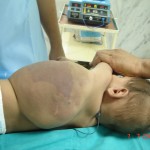
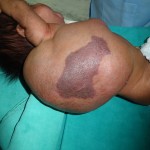 Large Lymphangio-Hemangiomas
Large Lymphangio-Hemangiomas

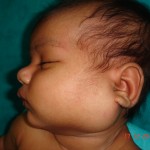 Lymphangiomas in the neck
Lymphangiomas in the neck
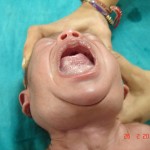 Large Lymphangioma in the neck
Large Lymphangioma in the neck
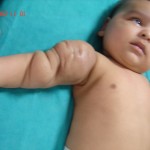 Lymphangioma over the arm
Lymphangioma over the arm
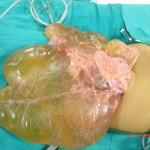 Abdominal Lymphangioma
Abdominal Lymphangioma
GUJARATI
લિમ્ફેન્જયોમા
બાળકનું શરીર બે કોષમાંથી આકાર લેતું હોય છે. આમાંથી ચેતાઓ, ધમનીઓ અને લિમ્ફેટીક નામની ગ્રંથિઓના કોષ પણ છૂટા પડતા હોય છે. લિમ્ફેટીક નામની નળીઓ બનાવતા કોષ જે નોર્મલ કોષથી છુટા પડીને ગાંઠ બનાવે તેને લિમ્ફેન્જયોમા કહેવામાં આવે છે. હિમેન્જયોમા એટલે કે લોહીની નળીઓની ગાંઠથી વિપરીત લિમ્ફેન્જયોમા તેની જાતે ક્યારેય મટતું નથી તેના માટે આપરેશન જરૂરી હોય છે. આપરેશન દરમિયાન જા ગાંઠ સંપૂર્ણપણે ન નીકળે તો ભવિષ્યમાં આ રીતની ગાંઠ ફરી થવાની શક્યતા રહે છે. હિમેન્જયોમાની જેમ જ લિમ્ફેન્જયોમા પણ શરીરના કોઈ પણ બાહ્ય અથવાતો આંતરિક અવયવ કે વિભાગમાં થઈ શકે છે. સામાન્ય પણે તો તે ગળામાં અથવા બગલમાં વધુ જાવા મળે છે. •
HINDI
लिम्फेंजीयोमा
बालक का शरीर दो कोशिकाओं में से आकार प्राप्त करता है। इसमें नसें, धमनियाँ और लिम्फेटिक नामक ग्ा्रंथियों की कोशिकाएं अलग हो जाती है। लिम्फेटिक नामक नलिकाएं बनाने वाली कोशिकाएं सामान्य कोशिकाओं से अलग होकर जो गांठ बनाती है उसे लिम्फेंजीयोमा कहा जाता है। हिमेंजीयोमा अर्थात खून की नलिकाओं की गांठ के विपरीत लिम्फेंजीयोमा कभी भी अपने आप ठीक नहीं होता है और उसके लिए ऑपरेशन जरूरी हो जाता है। ऑपरेशन के दौरान यदि गांठ पूरी तरह से नहीं निकाल ली जाती तो भविष्य में गांठ फिर से उभर आने की संभावना बनी रहती है। हिमेंजीयोमा की भान्ति लिम्फेंजीयोमा भी शरीर के किसी भी बाहरी अथवा अंदरुनी भाग में हो सकता है। •




